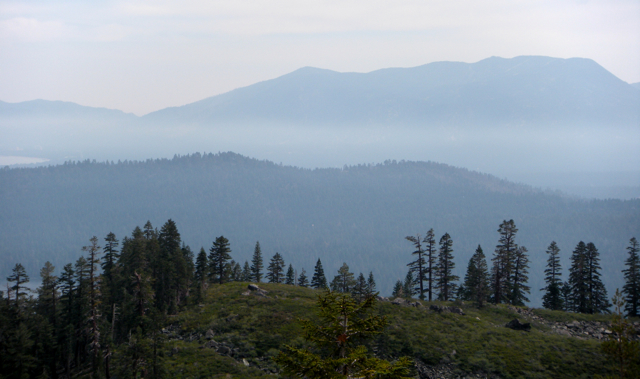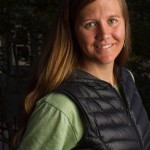Air pollution a silent killer — here and worldwide

Smoke from fires outside the Tahoe basin is an uncontrollable source of air pollution. Photo/LTN file
By Linda Fine Conaboy
RENO – “What you can’t see can kill you” was part of the message delivered this week by an expert in air pollution.
“Our air quality depends on the time of year. During wildfires and winter inversions, it’s awful,” Heather Holmes, an assistant professor in the Departments of Physics and Atmospheric Sciences at UNR, said April 3 during a talk the Galena Creek Visitor Center.

Heather Holmes
In the West, forest fires are a prime source of air pollution. In Reno and in Salt Lake City where Holmes earned her master’s and doctorate degrees at the University of Utah, temperature inversions, especially in the winter, can wreak havoc as they have their way with the air people breathe.
However, she said Reno is a poster child compared to some cities in Asia—think Beijing and Shanghai.
Holmes became fascinated by indoor and urban air pollution led her to conduct studies with others along the Mexican border in the town of Nogales, as well as in Bangladesh.
In Mexico, the team of researchers studied the effects of cooking indoors on wood burning stoves.
“Basically, in Mexico, we did surveys asking people about their health and quantifying the air pollution levels indoors. We found that children in Nogales had increased rates of asthma,” Holmes said.
But because of little medical care, the undiagnosed asthma was chalked up to repeated, simple colds, she said.
Having that experience led her to Bangladesh, a country of nearly 170 million, where she combined forces with another professor doing water studies. They built an investigative team that was intent upon learning even more about the harmful effects indoor cooking has on humans, especially women, who in Bangladesh do most of the familial food preparation.
They found that these women suffered appalling health, almost as if they smoked cigarettes. It’s easy to see why considering their fuel sources include cow dung, trash loaded with chemicals, plastics, tires and whatever else they can find to burn.
More than 4 million Bangladeshis die each year from exposure to indoor air pollution, and using spirometers, instruments necessary to measure lung function, the team found that as the air quality got worse, lung function decreased.
Globally, Holmes said, the fact remains that the largest environmental risk factor is pollution.
The United States is not without its inherent pollutants, and now people are becoming aware of them. In Washoe County, pollutants that are measured at various sites within the county including at Lake Tahoe include:
· Particulate matter such as dust, soot and unburned fuel suspended in the air. Sources can be wood stoves, industry, construction, street sand and open burning.
· Sulfur dioxide, a gas that is invisible and has a nasty, sharp smell. Volcanoes and fossil fuel combustion produce sulfur dioxide, but according to Holmes, about 99 percent of the sulfur dioxide in air comes from human sources. It can worsen respiratory disease and can aggravate existing heart disease.
· Nitrogen oxides, poisonous gases that can be sourced from fossil fuels and industrial equipment. They are harmful to the lungs.
· Carbon monoxide, an odorless gas emitted from combustion. Sources include cars, wood stoves, open burning and industry. Can cause dizziness, headaches, nausea and in high doses, death.
· Ozone. Can be caused by autos, power plants and industry. Ozone can be the source of irritated eyes, noses, respiratory systems and throats. Especially bad for people with chronic heart and lung disease.
· Relative humidity, wind direction, wind speed and ambient temperature are also measured by Washoe County and help determine amounts of pollutants in the air.
Since wood stoves can be sources of pollution, Washoe and El Dorado counties have a wood stove exchange and rebate program.
Go online, type in a ZIP code to find out what is happening air quality-wise in that location. The National Oceanic & Atmospheric Administration site also have information. During fires websites for the counties in the Tahoe basin and surrounding region often have air quality information that lists health advisories.


